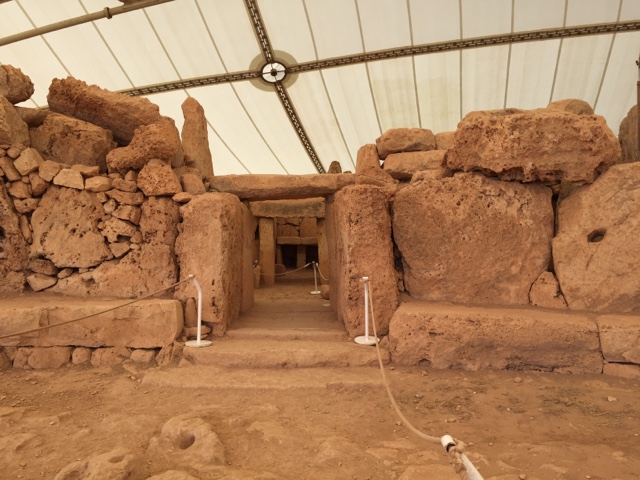Today our group had its first excursion for the Maltese History course we are all involved in. After some drama concerning our van, which arrived 20 minutes late to pick us up, we managed to make it to the Hagar Qim (Hahd-jar kEEM) temple site only slightly behind the appointed time.
 |
| Entrance to Hagar Qim |
We were met there by Dr. Nicholas C. Vella, Senior Lecturer in Archaeology at the University of Malta. Nick had given us an absolutely fantastic lecture on campus yesterday about late prehistoric Malta (yes, really!), so we were very much looking forward to having him as our guide.
 |
| Dr. Vella leads us to the entrance |
The site is on the southwest coast of the main island of Malta, near one of the only places where the sea is accessible along this coast -- most of the rest is characterized by steep cliffs. Some very small islets or large rocks are off shore near here.
 |
| Portals between rooms, carved into the rock |
There are actually several "megalithic" (big rock) temples on this site. Technically, Hagar Qim is the upper temple complex, and down the hill about 500 meters, closer to the sea, is another complex called Mnajdra (the closest I can come to mispronouncing it is "mmNEYE-drah").
 |
| Entrance to Mnajdra |
Both sites began to be developed around 3600 BCE or before, making them at least 500 years older than Stonehenge or any other free-standing megalithic structure in the world. They were expanded and remained in use for over 1000 years.
 |
| Holes drilled into the globigerina, for decoration? |
The basic architecture of all of them is very similar, based on two semi-circular rooms on opposite sides of a entrance hallway. The hallway usually ends in a smaller semicircular apse or large niche. This design is totally unique to Malta, and does not appear anywhere else in the world.
 |
| Part of Hagar Qim is aligned with the islet off shore |
Hagar Qim appears to have started out as a single, simple structure with two rooms and a central apse, looking something like a 3-leaf clover if viewed from above. It was expanded over time to add at least six rooms (or more, depending on how one counts) in a complex labyrinth.
 |
| This carving helps archaeologists know what the exterior of Mnajdra originally looked like. |
Mnajdra also began as a simple structure, but then another was built near it, and finally a larger one squeezed in between the two. Only one of these seems oriented to track the sun from solstice through equinox to solstice.
 |
| The cove, a rare break in the cliff face of the western shoreline of Malta. |
Hagar Qim is made primarily of soft, "globigerina" limestone. Mnajdra had an exterior of much harder "coralline" limestone, but an interior of globigerina stone that was easier to carve. Because the globigerina has deteriorated rapidly since being exposed, protective shelters were placed over both sites in 2009.
The sites were dug up by British treasure hunters back in the 1830s. In their diaries, they boasted that they carted away as refuse "wagon-loads" of broken pottery and animal bones. No one knows what became of these, but today's archaeologists would have loved to analyze all of it. The destruction wrought by these first diggers has left many mysteries here that will probably never be solved.
 |
| The surrounding countryside -- plenty of rock |
Were these structures actually temples, as seems likely, or did they serve some other function? What sorts of deities were worshiped here? What kinds of rituals were performed? How did the people who worshiped here live day to day? After more than a millennium, why did the people who built and used these structures suddenly abandon them? Dr. Vella encouraged us to make our best guesses based on the available evidence, because that's what archaeologists do.











No comments:
Post a Comment